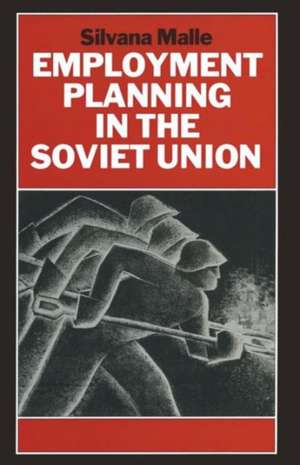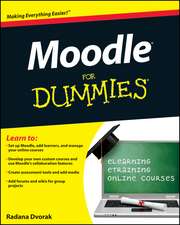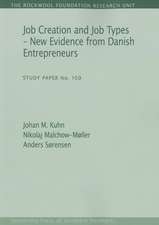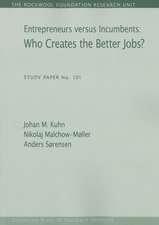Employment Planning in the Soviet Union: Continuity and Change: Studies in Russian and East European History and Society
Autor Silvana Malleen Limba Engleză Paperback – 1990
Din seria Studies in Russian and East European History and Society
-
 Preț: 171.09 lei
Preț: 171.09 lei - 15%
 Preț: 643.34 lei
Preț: 643.34 lei - 18%
 Preț: 953.65 lei
Preț: 953.65 lei - 15%
 Preț: 644.18 lei
Preț: 644.18 lei - 15%
 Preț: 638.89 lei
Preț: 638.89 lei - 18%
 Preț: 729.23 lei
Preț: 729.23 lei - 15%
 Preț: 643.99 lei
Preț: 643.99 lei - 15%
 Preț: 642.03 lei
Preț: 642.03 lei - 15%
 Preț: 637.25 lei
Preț: 637.25 lei - 15%
 Preț: 642.03 lei
Preț: 642.03 lei - 15%
 Preț: 643.65 lei
Preț: 643.65 lei -
 Preț: 279.60 lei
Preț: 279.60 lei -
 Preț: 383.12 lei
Preț: 383.12 lei -
 Preț: 386.99 lei
Preț: 386.99 lei - 15%
 Preț: 584.76 lei
Preț: 584.76 lei -
 Preț: 384.09 lei
Preț: 384.09 lei - 15%
 Preț: 642.83 lei
Preț: 642.83 lei - 18%
 Preț: 726.85 lei
Preț: 726.85 lei - 15%
 Preț: 587.53 lei
Preț: 587.53 lei -
 Preț: 388.72 lei
Preț: 388.72 lei - 15%
 Preț: 641.71 lei
Preț: 641.71 lei - 15%
 Preț: 642.83 lei
Preț: 642.83 lei - 15%
 Preț: 644.30 lei
Preț: 644.30 lei - 15%
 Preț: 643.00 lei
Preț: 643.00 lei - 15%
 Preț: 647.27 lei
Preț: 647.27 lei - 15%
 Preț: 644.49 lei
Preț: 644.49 lei - 15%
 Preț: 643.84 lei
Preț: 643.84 lei - 15%
 Preț: 641.71 lei
Preț: 641.71 lei - 15%
 Preț: 640.71 lei
Preț: 640.71 lei - 15%
 Preț: 641.85 lei
Preț: 641.85 lei - 18%
 Preț: 945.79 lei
Preț: 945.79 lei - 15%
 Preț: 642.36 lei
Preț: 642.36 lei - 22%
 Preț: 653.09 lei
Preț: 653.09 lei
Preț: 389.11 lei
Nou
Puncte Express: 584
Preț estimativ în valută:
74.45€ • 77.95$ • 61.61£
74.45€ • 77.95$ • 61.61£
Carte tipărită la comandă
Livrare economică 07-21 aprilie
Preluare comenzi: 021 569.72.76
Specificații
ISBN-13: 9781349115907
ISBN-10: 1349115908
Pagini: 334
Ilustrații: XII, 334 p.
Dimensiuni: 140 x 216 x 20 mm
Greutate: 0.44 kg
Ediția:1st ed. 1990
Editura: Palgrave Macmillan UK
Colecția Palgrave Macmillan
Seria Studies in Russian and East European History and Society
Locul publicării:London, United Kingdom
ISBN-10: 1349115908
Pagini: 334
Ilustrații: XII, 334 p.
Dimensiuni: 140 x 216 x 20 mm
Greutate: 0.44 kg
Ediția:1st ed. 1990
Editura: Palgrave Macmillan UK
Colecția Palgrave Macmillan
Seria Studies in Russian and East European History and Society
Locul publicării:London, United Kingdom
Cuprins
Part 1 Employment planning and labour balances: employment planning - an outline of theoretical and practical issues; labour balances and employment growth; labour shortage and excess labour - branch and territorial imbalances. Part 2 Labour redeployment - trends and institutions: labour redistribution; labour redeployment under "perestroika"; the administration of labour displacement - the Job Placement Bureaux; labour law and job rights. Part 3 The demand for labour; the enterprise demand for labour; the output - versus the employment-oriented approach - the notion of workplace; excess-capacity - a new definition of labour shortage; capacity-labour balance model. Part 4 Production capacity utilization and knowledge: production capacity utilization and shift regime - indicators and quality of information; information and capacity utilization in theory; information on capacity utilization in practice; contradictory information and investment policy; actual and expected outcomes. Part 5 Labour-saving - notion and indicators; labour value of output and productivity; labour-release in planning theory - relative release versus absolute release, conventional labour-release; the principles of labour-saving at the enterprise level; labour-saving in practice - the physical indicators; the rationale of limits on employment; the branch limits on employment; the territorial limits on employment. Part 6 Wages, employment and labour-saving: outline of Soviet wage policy - theory and practice; the wage-productivity relation and employment; labour-saving through wage incentives - experiments and model; wage control - wage norms and the principle of residual formation of the wage fund; the wage reforms - increased differentiation in wage rates and bonuses; the implementation of the wage reform. Conclusion: concluding remarks and discussion of the options for the 1990s.














